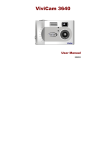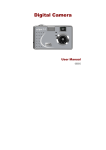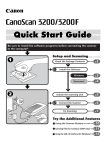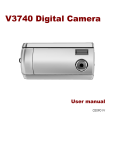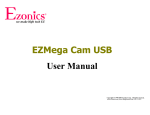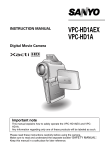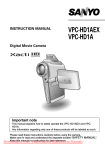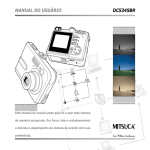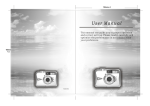Download Vivitar ViviCam 3610 Digital Camera
Transcript
Digital Camera User Manual 020910 About this manual Preface This manual is designed to make using the Digital Camera as easy as possible. Information in this document has been carefully checked for accuracy; however, no guarantee is given to the correctness of the contents. The information in this document is subject to change without notice. Copyright © Copyright 2002 This document contains proprietary information protected by copyright. All rights are reserved. Trademarks All trademarks and registered trademarks are the property of their respective owners. Photo Express, DVD PictureShow, Cool 360 and PhotoExplorer, Copyright 2002, Ulead Systems Inc., All Rights Reserved. Presto! VideoWorks, Presto! Image Folio and Presto! Mr. Photo, Copyright 2002, NewSoft Technology Corporation , All Rights Reserved. ii Table of Contents Chapter 1 - Getting Started.............................................................. 1 Features ..................................................................................... 1 Safety Information.................................................................... 2 Included Components............................................................ 3 Camera Overview ................................................................... 5 Front View .................................................................... 5 Back View .................................................................... 7 Bottom View .............................................................. 10 Install the Memory Card ....................................................... 11 Install the Batteries ................................................................. 13 Choose a Language ............................................................. 15 Set the Time and Date .......................................................... 16 Chapter 2 - Taking Pictures............................................................. 18 Ready the Camera ............................................................... 18 Select the Camera Mode .................................................... 19 Frame the Shot ....................................................................... 20 Zoom and Shoot..................................................................... 21 Shut the Camera Down........................................................ 21 Chapter 3 - Reviewing Your Pictures ............................................. 22 Switch to Playback Mode .................................................... 22 Full-Screen Review ................................................... 22 Thumbnail Review .................................................... 23 iii Chapter 4 - Connecting to a Computer........................................ 24 Installing Software .................................................................. 25 Making the Connection ....................................................... 27 Copying Images to PC ......................................................... 28 Using as a PC Camera.......................................................... 29 Chapter 5 – Mode / Operation Guide ........................................... 30 Using Snapshot Mode ........................................................... 30 Using Timer Mode................................................................... 31 Using Preset Mode ................................................................. 32 Using Playback Mode ........................................................... 33 Using Setup Mode.................................................................. 35 Delete / Format ........................................................ 36 Quality ........................................................................ 37 DPOF ........................................................................... 38 Date/Time .................................................................. 39 Language .................................................................. 40 Storage Media .......................................................... 40 TV Setting ................................................................... 41 Chapter 6 – Using the LCD Display ................................................. 42 Icon Descriptions.................................................................... 43 Appendix 1 – Button Function Guide ............................................. 45 Appendix 2 – Troubleshooting ........................................................ 46 iv Chapter 1 - Getting Started Features • • • • • • • • • • • Digital Zoom Up to 2048 x 1536 resolution Color LCD viewfinder screen Video Clip Recording (up to 1 minute) 2 megapixel sensor resolution USB 1.1 interface Auto exposure, fixed focus Flash Modes: Auto / Red-Eye Reduction / OFF White Balance Modes: Auto/ Daylight / Shade / Tungsten / Fluorescent 10 second Timer mode Full screen or Thumbnail preview 1 Digital Camera User’s Manual Safety Information l Do not look at the sun through the viewfinder. Viewing the sun or other strong light source through the viewfinder could cause permanent visual impairment. l Do not disassemble the camera. Touching the product’s internal parts could result in injury. In the event of a malfunction, only a qualified technician should repair the product. Should the product break open as a result of a fall or other accident, remove the batteries and take the product to an authorized service center for inspection. l Avoid contact with liquid crystal. Should the LCD display break, care should be taken to avoid injury due to broken glass and to prevent the liquid crystal from touching the skin or entering the eyes or mouth. l Do not use in the presence of flammable gas. Using electronic equipment in the presence of flammable gas could result in explosion or fire. l Observe proper precautions when handling batteries. Uses only size AA alkaline batteries. Batteries may leak or explode if handled improperly. Remove the batteries and memory card from the camera if you intend to store the camera for extended periods of time. Be sure the camera is turned off before inserting or removing batteries. Do not insert batteries backwards or upside down. Do not disassemble batteries. Do not expose batteries to flame or excessive heat. Do not immerse batteries in or expose to water. Discontinue use immediately if you notice any change in the battery such as discoloration, deformation or leakage. l Observe caution when operating the flash. Do not use the flash close to anyone’s eyes. This can cause temporary damage to eyesight. Particular care should be observed when photographing infants – keep the flash at a distance of at least 1 meter from infants’ eyes. 2 Included Components Your digital camera comes equipped with the following components. Please check to make sure all items are included. Contact your retailer immediately if any of the following components are broken or missing: 1. 2. 3. 4. 5. Digital Camera User’s manual Quick Reference Guide USB cable Two (2) AA alkaline batteries 3 Digital Camera User’s Manual 6. 7. 8. 4 Installation CD-ROM Soft carrying case Hand strap Camera Overview The front view, rear view, bottom view and top view of the digital camera are shown below. Please take a moment to review these illustrations to familiarize yourself with the terms used in the rest of this manual. Front View 5 Digital Camera User’s Manual 1. Shutter Button: Press to take photos and select options from the menus. 2. Built-in Flash: The flash allows the camera to take pictures in low light conditions and can also be used as a fill-in flash for bright conditions that may have unwanted shadows. 3. Light Sensor: The digital camera can automatically detect the ambient light level and determine whether or not the flash is needed. The light measurements are made from this sensor. Take care not to block the sensor with your finger while taking a picture. 4. Viewfinder: The viewfinder can be used to estimate what the picture frame will include. The actual picture is taken from the lens not the viewfinder. 5. Self-Timer LED: When the mode dial is set to Self-Timer and a picture is taken, this LED will blink for ten seconds and then the camera will take a picture. 6. Lens: The lens focuses the light onto the digital image capturing circuitry. For the best picture quality, care should be taken to make sure it remains free of dust, fingerprints, and scratches. 6 Back View 1. Viewfinder: The viewfinder can be used to estimate what the picture frame will include. The actual picture is taken from the lens not the viewfinder. 2. Status LED: When power is first turned on, or the camera is working (and not available to take a picture), the LED will flash. When the 7 Digital Camera User’s Manual camera is ready to take a picture or accept user commands, the LED will be a solid green color. Power Button: Use this button to turn on the digital camera. Press the same button to turn it off. Zoom Out Key: During playback, this key 4. can be used to zoom out. If pressed repeatedly, Zoom Out can also be used to switch between thumbnail and fullscreen views. Zoom In Key: During playback, this key 5. can be used to zoom in for a closer view of your picture. 3. Mode Dial: Rotate this dial to select which mode the camera is using: Snapshot, Timer, Preset, Playback, or Setup. 7. Shutter Button: While taking pictures, use this button to capture a digital image. While navigating in the menus, use this button to select a menu item. USB Port: The USB (Universal Serial Bus) 8. port is used to connect the camera to a PC for transferring images, and for use as a PC Video Camera. 9. Hand Strap Loop: Attach the hand strap to this loop for ease of carrying. 6. 8 10. Up Key: During playback, used to select the next picture. 11. Down Key: During playback, used to select the previous picture. 12. Strobe / Copy: During playback, used to copy a picture. WB/Delete: Press this button to cycle through the White Balance presets: Auto, Daylight, Shade, Tungsten and Fluorescent. 14. Display Key: Press this button to cycle through the various display options: LCD, backlight and status information all turned on; LCD and backlight on but no status information; and LCD off. 15. LCD Display: The LCD display can be used to preview what your photos will look like. While using the Setup menu, you will use the LCD to see messages and configure the camera. 13. 9 Digital Camera User’s Manual Bottom View 1. 2. 3. 4. 10 Tripod Connector: Use this connector to attach a tripod to the camera. A tripod is an optional accessory that can be used to hold the camera very still and is especially useful for low light night pictures. It can also be helpful when nobody can hold the camera, such as when taking group pictures using the timer mode. Battery / Memory Card Cover: Allows access to the 2 AA sized alkaline battery chambers as well as the memory card slot. Memory Card Slot: To store your images on an external memory card, insert a SmartMedia™ memory card into this slot and change the Storage Media option to External. Battery Chamber: Insert two AA alkaline batteries. Install the Memory Card Follow these steps to install the memory card: 1. Make sure the camera is turned off. 2. Open the battery / memory card compartment by pressing on the cover and sliding in the direction of the arrow toward the outside edge of the camera. 11 Digital Camera User’s Manual 3. Insert the memory card with the slotted corner facing the outside edge of the camera (gold circuitry facing toward the back of the camera). Notch 4. 12 Close the battery / memory card cover. Install the Batteries Follow these steps to install or replace the batteries: 1. Make sure the camera is turned off. 2. Open the battery compartment on the bottom of the camera. 13 Digital Camera User’s Manual 14 3. Insert batteries into the chamber making sure that the positive and negative ends are properly oriented with the polarity indicated on the inside of the compartment. 4. Close the battery cover. Choose a Language The digital camera can display text and messages in English, French, Spanish and German. Follow these steps to select a different language: 1. Rotate the Mode Dial to the Setup mode 2. Turn the camera on. . 15 Digital Camera User’s Manual 3. Use the Down Key to select Language then press the Shutter Button to enter this menu. 4. Use the Down Key and Up Key to select which language you want to use. Press the Shutter Button to select the language. Set the Time and Date If the time and date are properly set, the digital camera will mark each picture with this information. The benefit of having the time and date set is that when you transfer the images to a computer, the file properties will show the correct time and date that the picture was taken. To set the time and date: 1. 16 Set the Mode Dial to Setup . 2. Turn the camera on. 3. Use the Down Key to select Date/Time, then press the Shutter Button to enter this menu. 4. and Up Key to adjust Use the Down Key the hour, then press the Shutter Button to set the minutes. Once the time is set, press the Shutter Button to set the year, then the month, and finally the day. 5. When the settings are correct, press the Display Key to save the date and time and return to the Setup Menu. 17 Digital Camera User’s Manual Chapter 2 - Taking Pictures This chapter guides you through taking pictures with the digital camera. Ready the Camera Follow these steps to make sure the camera is ready to take pictures: 1. Press the Power button to turn the camera on. After a short pause, the LED will stop flashing, which is the signal that the camera is ready for use. Make sure you have installed 2 Alkaline size AA batteries. If you want to store your photos on a memory card, make sure it is also installed before you turn on the camera. If you want to store images directly to the camera's internal memory, either remove the memory card, or select Internal from the Storage Media menu. Using the LCD display consumes more battery power. To prolong the life of your batteries it is highly recommended to keep the LCD display shut off when not in use. 18 Select the Camera Mode There are three modes that can be used to take pictures: Snapshot mode, Timer mode and Preset mode. Snapshot mode is used for basic picture taking while the Timer mode allows you to take a picture after a 10 second delay. Preset mode allows you to take pictures in one of three preset schemes: Monochrome (B&W), Sepia, or Video Clip. Rotate the Mode Dial to the mode you wish to use. For basic “point and click” picture taking, you can use the . To Snapshot mode indicated by the camera icon use the self-timer, rotate the Mode Dial to the timer icon . To take pictures in either Monochrome or Sepia presets, rotate the Mode Dial to Preset and select Sepia or Monochrome. 19 Digital Camera User’s Manual Frame the Shot To prevent the camera from shaking (resulting in blurry pictures), hold the camera steadily with both hands. You can use either the Viewfinder or the LCD display to preview the picture, whichever best suits your shooting conditions. Turning off the LCD display and taking pictures using the Viewfinder will result in longer battery life, however, it may be more convenient to use the LCD display in some situations. Hold the camera with thumb and forefingers of both hands on either side of the camera, with the forefinger of your right hand on top of the Shutter Button. To avoid accidentally obscuring the picture, keep your fingers and other objects away from the lens, flash, and sensors on the front of the camera. 20 Zoom and Shoot Zoom in on a particular object You can use the Zoom In or Zoom Out buttons to zoom in or out. Use the LCD display to preview the effects of the zoom function. Shoot the picture When you are happy with the preview, slowly press the Shutter Button. (Quickly pressing the Shutter Button might shake the camera and cause a blurry picture.) Automatic Image Processing Press the Shutter Button half way to initiate the camera's internal image processing function. The camera will adjust the image due to background lighting, and, if in auto-flash mode, detect whether or not the flash is required. Press the rest of the way to capture the image. Shut the Camera Down When you are finished taking pictures, make sure to shut the camera off to conserve battery power. 21 Digital Camera User’s Manual Chapter 3 - Reviewing Your Pictures One of the benefits of digital cameras is that you can immediately check whether or not you like the picture you just took. No more nasty surprises when the pictures come back from developing! After you take a picture you can see what it looks like and retake it if dissatisfied. Switch to Playback Mode To view the pictures that you have stored in internal memory or on the SmartMedia™ Card, rotate the Mode and turn the camera on. Dial to Playback Mode If the LCD is not turned on, press the Display Key turn it on. You can cycle through these modes by repeatedly pressing the Display Key. to Full-Screen Review The default Playback mode is to show the pictures in fullscreen. In this mode you can press the Up Key 22 and Down Key to cycle through the pictures in the camera's memory. You can also use the zoom keys to zoom in to see more detail on a particular picture. The default zoom setting is "x1"; Press "Zoom In" to increase zoom through the following zoom ratios: x1.0, x1.2, x1.4, x1.6, x1.8, x2.0. Press the "Zoom Out" to decrease zoom ratio (from x2.0 down to x1). Thumbnail Review key when the zoom ratio is If you press the Zoom Out at x1 (default), you will enter the Thumbnail Review mode. In Thumbnail Review mode, four pictures will be shown on the LCD at the same time. You can use the Up Key and Down Key to scroll through the pictures. You will probably find this is a much faster way to find a particular photo. To return to full-screen review mode, select the photo you want to view and press either the Shutter Button or the Zoom Out button. The selected picture will then be shown expanded to fill the entire LCD. 23 Digital Camera User’s Manual Chapter 4 - Connecting to a Computer The digital camera stores pictures as digital data rather than using film. Instead of making a trip to a developer and getting negatives, you can simply copy your pictures to a computer for long-term storage. Once transferred to your computer, your pictures can be viewed, printed, sent to your friends and family via email, or saved to any removable media (such as floppy disk or CD-ROM) for delivery to a photofinisher. After transferring pictures to your computer, any copies stored on the memory card or on the camera's internal memory can be deleted to make way for new pictures, which you can then add to the growing digital photo album on your computer. This chapter explains how to connect your digital camera to a computer for either downloading pictures to the PC or using as a PC Camera. Do not connect the camera to your computer before installing the software. This may cause installation problems. Please make sure you install the software from the CD-ROM prior to connecting the camera to your computer. 24 Installing Software Follow these instructions to install the digital camera drivers and software on your system. Pease also have your Windows CD-ROM ready beforehand, as you may be prompted to insert it during the installation process. Step 1: TWAIN Driver / Utility Installation 1. At this point, do not connect the camera to your PC. Insert the installation software CD into your CD-ROM drive. 2. The installation program should start automatically. If not, double click the My Computer icon on your desktop, double click on your CD-ROM drive, and double click the 'setup.exe' icon in the root directory of the installation CD-ROM. 3. Follow the on-screen instructions. All the necessary software will be installed automatically. The TWAIN drivers and utility program that allow the camera to 'talk' to the computer via the USB cable will be installed. 25 Digital Camera User’s Manual Step 2: MSD / PC Camera Driver Installation 26 1. To install the necessary drivers for Mass Storage Device (MSD) mode and PC Camera mode, first set the correct operational mode for that for PC function (set Mode Dial to Setup Camera mode, or to any other setting for MSD mode). 2. Connect the small connector of the USB cable to the camera, as shown: 3. Connect the large connector of the USB cable to an empty USB slot on your computer. To locate USB slots on your computer, find the USB icon . 4. The Windows Add Hardware Wizard will automatically detect the camera and lead you through the installation procedures for the corresponding mode. 5. You will need to do this once for each mode (PC Camera and MSD). See the following sections for details on PC Camera and MSD modes. Reboot your computer before using camera and software for the first time. Remember that you will need to connect your camera to the PC with the USB cable before being able to download pictures. Making the Connection The camera is enabled with two modes when connected to your computer: • • Mass Storage Device (MSD) PC Camera MSD mode allows you to use the camera just like a standard storage device, copying, deleting and moving files to and from the camera like a normal disk drive. PC Camera mode allows you to use the camera as a standard PC video camera, for video teleconferencing, security, videophones, etc. Use the supplied USB cable to connect your digital camera to your PC for use as either a MSD or a PC Camera. 27 Digital Camera User’s Manual Copying Images to PC When connected to your computer in MSD mode, the digital camera will behave exactly like another disk drive on your computer. This makes copying the images to your hard drive as easy as copying files from a floppy disk to your hard drive. Make sure the camera is turned on and is NOT in the Setup mode. (Setup mode is used for PC Camera mode and cannot be used to copy images. See the PC Camera section below.) After connecting the digital camera to the computer, open the Windows Explorer by double-clicking on the My Computer icon on your desktop. The contents of your computer will be displayed, including all your disk drives, and, if the camera is connected, an extra disk drive that represents the camera's memory. Double click the digital camera drive to see all the photos located in the camera. Select the photos and drag and drop them onto your computer’s hard disk. 28 Using as a PC Camera To use the digital camera as a PC Camera, you must make sure the camera is set to the Setup mode. Rotate and then connect the Mode Dial to the Setup Mode the camera to the computer using the USB port. When connected, the camera can be used in conjunction with any commercially available video capture software to create your own home videos. Then you can edit and distribute your video files through the Internet or save them to CD-ROM for later viewing on your PC or through a VCD player (CD burner required). It can also be used with software such as Microsoft NetMeeting™ for real-time videoconferencing. To use the digital camera as a PC Camera you must set the camera to the Setup mode. To use the digital camera in MSD mode, you can use any of the modes except for the setup mode. 29 Digital Camera User’s Manual Chapter 5 – Mode / Operation Guide The digital camera has five separate modes of operation. You can select which mode you want to use by rotating the Mode Dial to the correct position. This chapter describes each of these modes and the different button functions in each mode. Using Snapshot Mode The Snapshot mode is used for basic picture taking. The following control buttons can be used in Snapshot mode: 30 • Display Key: Pressing this key will rotate through the following LCD display settings: LCD, backlight and status information all turned on; LCD and backlight on but no status information; and LCD off. • Strobe / Copy: This key determines how the strobe light (flash) is to be used. Pressing the Strobe key rotates through the settings: Auto (A), Off, and Red Eye Reduction. • WB / Delete: This key adjusts the White Balance settings. Pressing the WB key rotates through the settings: Auto, Day Light, Shade, Light bulb (incandescent light), and fluorescent light. • Zoom Out: This key can be used to zoom out showing a wider picture. • Zoom In: This key can be used to zoom in showing a particular object in more detail. Using Timer Mode The Timer mode is used to take a picture after a ten second delay. An example use of the Timer mode is shown below. Taking a Group Photo If you want to take a picture of a group and you want yourself to be included in the picture, you can use the Timer mode. Follow these three steps: 1. Position the camera and frame the shot using an optional tripod (or a stable surface). 2. Make sure the digital camera is set to Timer mode and press the Shutter Button. 3. The camera will automatically take a picture after a 10 second delay. 31 Digital Camera User’s Manual All the camera buttons behave exactly as in the Snapshot mode. (Except in this mode the Shutter Button will cause the ten-second countdown to start.) Using Preset Mode Preset Mode has three presets for taking particular types of pictures: Monochrome, Sepia and Video Clip. Select the Preset option for the type of picture you want to take using the Up and Down buttons, and then press the Shutter Button. Sepia: Photographers to create a warmer print tone use sepia toning. The shadows remain black while the midtones of the image are adjusted towards brown and orange colors. This produces a warm, old-fashioned look for creating artistic style photographs. Monochrome: Black & white. Pictures include no colors except black, white and shades of gray. This is another easy way to add distinctiveness to your pictures. 32 Video Clip: Allows you take record 60-second, 320x240 resolution movies to your camera’s on-board memory or the SmartMedia™ card. Note: The camera doesn’t record audio. To record a video clip: 1. Turn the Mode Dial to the Preset mode setting. 2. Use the Up and Down buttons to select the Video Clip preset. 3. Frame your shot. 4. Press the Shutter Button to begin recording. By default, the camera will record a full 10-seconds before terminating the recording. However, if you want to terminate the recording sooner, press the Shutter button a second time. Using Playback Mode The Playback mode is used to view the pictures that are stored in the digital camera’s onboard memory or on the memory card. To view the photos, rotate the Mode Dial to the Playback mode position and if the LCD display is off, press the Display button to turn it on. 33 Digital Camera User’s Manual The following control buttons can be used in Playback : mode 34 • Up Key: Move to the previous photo. • Down Key: Move to the next photo. • Display Key: Pressing this key will rotate through the following LCD display settings: LCD, backlight and status information all turned on; LCD and backlight on but no status information; and LCD off. • Strobe / Copy: This key copies the selected image from onboard memory to the memory card or vice versa. • WB / Delete: This key deletes the selected photo. • Zoom Out: This key can be used to zoom out showing a wider picture. If you keep zooming out you will switch to Thumbnail mode where you can see 4 pictures on the screen instead of just one. • Zoom In: This key can be used to zoom in showing a particular photo in more detail. Using Setup Mode Setup Mode is used to configure the digital camera. To access the Setup menu, rotate the Mode Dial to the Setup Menu position. The Setup menu will be displayed on the LCD, as follows: Each of the setup menu items is described in the rest of this chapter. 35 Digital Camera User’s Manual Delete / Format To delete images from either the camera's internal memory or from the Memory Card, select Delete/Format from the Setup menu. The Delete / Format menu contains the following two sub options: Delete All: This option does a very quick erase of all pictures on the internal memory or memory card. (Which device is erased depends on which storage device is selected, see Storage Media for more information.) Format: This option will do a complete erase and reformat of the storage device. It works like formatting or defragmenting a hard drive. Although Format takes longer than Delete, be sure to format your storage device occasionally to ensure you have access to all the available memory. Select either Delete All or Format, and press the Shutter button. You will be asked to confirm deletion or format. 36 Select Yes and press the Shutter button to confirm. Press No to cancel and return to the Setup menu. As onboard memory may become fragmented over time, you should periodically Format your onboard memory to ensure you have access to all available memory. Quality Adjust the image quality (resolution) by selecting Quality from the Setup menu. 37 Digital Camera User’s Manual There are Four different picture resolutions available: 2048 x 1536 Super (~7 pictures) 1600 x 1200 High (~16 pictures) 1152 x 864 Fine (~35 pictures) 640 x 480 Normal (~108 pictures) The higher the quality, the clearer your picture will be, but at the same time the image file size will be larger, and therefore you will be able to store fewer pictures in memory. Generally, Normal quality (640 x 480) is high enough quality for most purposes. DPOF The Digital Printer Order Format (DPOF) mode can be used to directly print your photos to a printer that supports this function. 38 Select the image you wish to print or select All Images to print all images to the printer. Select Reset Setting to deselect images and disable the DPOF function. Date/Time If the date and time are properly set, the digital camera will mark each picture with this information. The benefit of having the date and time set is that when you transfer the images to a computer, the file properties will show the correct date and time the picture was taken. To set the date and time, select DATE/TIME from the Setup menu: Adjust the hour, minute, year, month and date using the Up and Down buttons, and press the Shutter button to confirm changes. Press the Display button to set the changes and return to the Setup menu. 39 Digital Camera User’s Manual Language The digital camera can display text in the following languages: English, French, Spanish, German, Italian, Dutch and Chinese (Simplified). To set the language for the LCD display, select Language from the Setup menu: Then choose the language using the Up and Down buttons, and confirm by pressing the Shutter button. Storage Media Use the Storage Media menu selection to choose whether you want to store the digital photos in the onboard memory (Internal) or on the removable memory card (External.) 40 Then choose the storage media using the Up Down button. and buttons, and confirm by pressing the Shutter TV Setting If connecting your camera to a television set by means of A/V cables, you have the option to choose a transmission format compatible with that of your TV. This allows you to record video images sent to the TV with a VCR. The camera does not support audio. Select the TV Setting option from the Setup menu, and then choose either NTSC or PAL, according to your hardware and region. Press the Shutter Button to confirm your choice. 41 Digital Camera User’s Manual Chapter 6 – Using the LCD Display When the camera is in any mode other than Setup mode, current camera settings such as zoom, icons on the LCD display indicate quality, etc. This chapter describes these icons and their meanings. 42 Icon Descriptions Icon Name Description Auto Flash The camera senses whether the flash is needed by detecting the amount of ambient light. Flash Off Flash is turned off, regardless of the amount of light available. Red-Eye Use the Red-Eye Reduction function to reduce the Reduction occurrence of "red-eye" (eyes appear red in the pictures due to flash reflection in dark pictures). This function causes the camera to flash quickly before the picture is taken to reduce red-eye. Flash On Flash is on, regardless of light available. Snapshot Indicates the camera is in Snapshot mode (the standard mode for taking pictures). Mode Video Clip Indicates the camera is in Video Clip mode (which allows you to record a 60-second video.) Mode Timer Mode Indicates the camera is in Timer mode. Pressing the Shutter button will initiate the 10-second count-down timer before taking a picture. Playback Indicates the camera is in Playback mode. This mode is used to view pictures stored on the camera's internal memory or on Mode the memory card. Normal Quality Indicates the camera's resolution is set to Normal (640 x 480). 43 Digital Camera User’s Manual Fine Quality Indicates the camera's resolution is set to Fine (1152 x 864). Super Quality Indicates the camera's resolution is set to Super (1600 x 1200). Zoom Indicates the level of zoom currently applied. Zoom options are: x1.0, x1.2, x1.4, x1.6, x1.8, x2.0. Battery Indicates the level of battery power remaining. Indicator Indicates the current White Balance setting. The default White Balance setting is Auto. Auto WB The camera automatically determines the White Balance setting. Daylight Use this setting when taking pictures in bright daylight, to reduce the effect of "whitewashed" pictures. Shade Use this setting when taking pictures in shade, or any time your pictures come out too dark. Tungsten Use this setting for taking pictures under tungsten or incandescent light. Fluorescent 44 Use this setting for taking pictures under fluorescent light. Appendix 1 – Button Function Guide Mode Shutter Up Key Down Key Display Strobe/ WB/ Delete Zoom Out Zoom In Copy Single Capture NA NA LCD + Light → LCD Off Flash Auto → Off → Red Auto Auto → Day light → Shade → Tungsten → FL Zoom Out Zoom In Single Capture NA NA LCD + Light → LCD Off Flash Auto → Off → Red Auto Auto → Day light → Shade → Tungsten → FL Zoom Out Zoom In Single Capture Select B/W or Sepia Preset color scheme Select B/W or Sepia Preset color scheme LCD + Light → LCD Off Flash Auto → Off → Red Auto Auto → Day light → Shade → Tungsten → FL Zoom Out Zoom In Select Photo Page Up Page Down LCD + Light → LCD Off Copy image to/from Internal /card Delete Zoom Out Zoom In NA NA NA REC/ DSC Timer Preset Playback Execute Function Select Select (snap shot) Select Select Setup NA = Not Available 45 Digital Camera User’s Manual Appendix 2 – Troubleshooting Problem Possible cause Solution The camera has no power. The camera is turned off. Press the power button to turn the camera ON. The batteries are Replace the batteries with fresh ones. discharged. Refer to Inserting Batteries. The batteries are Check the battery orientation. Refer to inserted Inserting the Batteries. incorrectly. The camera won’t take a picture. The flash doesn’t work. 46 Ensure that the green Camera Ready LED indicator is on and is not flashing. If the light is flashing, wait until it emits a steady light before taking a picture. The camera may be waiting for the flash to charge. Is the camera connected to a computer? The camera’s buttons are not functional when connected to a PC. Disconnect the camera to take more pictures. Is the flash on? Ensure that the flash is set to auto or always on. Refer to Setting the Flash. The batteries may be weak. If the batteries are too weak, the flash will be unable to recharge. Turn the camera off and wait a few seconds before turning it back on. If this doesn’t work, you will need to replace the batteries with fresh ones. Refer to Inserting the Batteries. The images are blurry. The camera or Hold the camera steady or put it on a subject was tripod to take pictures. moving when the shot was taken. The personal The camera was computer does not connected to a recognize the camera personal computer by USB before installing software. In Windows ME and Windows 2000, when the USB cable is unplugged from the PC, an "Unsafe Removal Device Detected" error message appears. Connect the camera to the computer with the USB cable. Select [My computer] > [Control panel] > [System] > [Device manager]. From [other devices] in [device manager], delete [Composite USB device] or [unknown device]. Disconnect the camera from the computer, install the software, and then reconnect the camera. When removing Procedure: USB devices, it is A. Right-click the Unplug or eject recommended hardware icon at the bottom-right that users follow of your computer screen. the "Safe B. Left-click the Unplug or eject Removal of USB hardware text box to bring up the Device" 'Unplug or Eject Hardware' procedure. screen. C. From the 'Unplug or Eject Hardware' screen, select the device to be disconnected and then click the Stop button to bring up the 'Stop a Hardware device' confirmation screen. D. From the 'Stop a Hardware device' confirmation screen select the device to be stopped and click OK to bring up the 'Safe To Remove Hardware' confirmation. E. You may now disconnect the Digital Camera from your PC. 47 Digital Camera User’s Manual Images lose formatting data during image capture in "PC Camera" mode. If your hard disk's DMA setting is turned off (Windows 98 and Windows ME only), images may lose formatting data during image capture. Please check to make sure your hard drive's DMA setting is enabled, as follows: 1. 2. 3. 4. 5. 48 From the Windows Start menu, select Settings, then Control Panel. In the Control Panel double-click System, then click the Device Manager tab. Select your hard drive from the list, then click Properties. Click the Settings tab. Make sure the box marked DMA is checked. If not, check the box to ensure that your hard drive will protect image attributes during capture.




















































